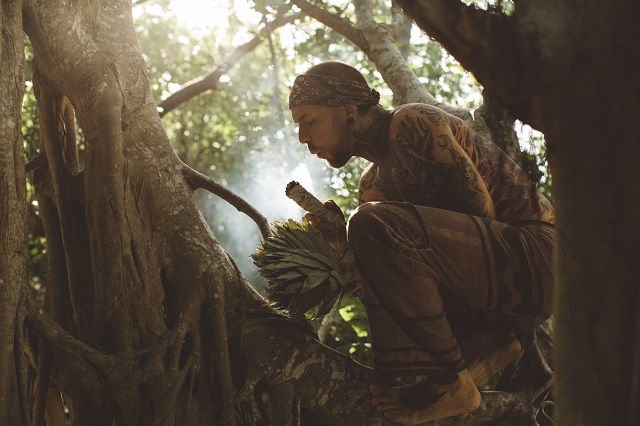This website is not designed to, and should not be construed to provide medical advice, professional diagnosis, opinion or treatment to you or any other individual, and is not intended as a substitute for medical or professional care and treatment. Always consult a health professional about before trying out new home therapies or changing your diet. ~ Ed.
~
There I was, surrounded by 20 adults in sleeping bags.
The room was candlelit, and everyone was wearing white. It looked like a cross between a séance and a slumber party.
Someone handed me a glass of viscous red liquid and (after briefly hoping I wouldn’t puke too much), I downed it in what I imagined was a ceremonial way—closing my eyes, and trying to look reverent.
This was the start of my first Ayahuasca experience.
I plodded back to my sleeping bag in my white leggings; the powerful, psychoactive substance coursing through my veins…
Like many people, I suffered from depression. It had been with me since childhood. I’d been actively working on “getting better” for 10 years, and I had made progress, just not as much as I wanted.
I knew all the theories about what caused depression—the chemical imbalance, the unresolved trauma, the bottling of emotion, the low self esteem—and my varied approaches had addressed each theory. I’d tried every diet under the sun: I did yoga, even became a yoga teacher, went to India to find myself, went for counseling, psychotherapy, acupuncture, Rolfing, Reiki, Reflexology, practised positive affirmations and the law of attraction.
It’s frustrating when we put a lot of effort into something, and don’t see the results we’re hoping for. No matter how deeply I understood myself, no matter how I released or expressed my feelings, no matter how positively I thought, or how many self-love affirmations I repeated, I was not healed.
I was here because I was at the end of my tether. I was sick of the cycle of drama-resolution. I wanted the truth. Was I going about healing wrong? Was there anything that could really work?
In the West, psychoactive substances are predominantly regarded on the spectrum of recreational toys to dangerous drugs. Except for a small body of psychologists and doctors who have done research in the field, the image is continually reinforced by governments with the ongoing “war on drugs,” and the media’s portrayal of “drug culture” in screen and literature.
I had already learned from direct experience that there was much more to them than that. In 2005, a truant magic mushroom had shattered my atheist worldview. It revealed a truth I could never have imagined—that an invisible energy permeates the universe. Voilà, spiritual awakening!
Ayahuasca appealed to me because it was treated with the reverence deserving of a spiritual protocol. I heard it treated physical and psychological disorders, brought unprecedented clarity, and empowered people to break deeply-held beliefs and patterns.
I also heard that it brought you face-to-face with your darkest demons and induced a catatonic purge. People were known to vomit, cry, shake, and cr*p themselves. Weighing up the pros and cons, let’s just say that I didn’t rush into this.
But here I was, and I thought I knew what to expect. Nothing could have prepared me for what came next.
It was bedlam. A dozen people were going through living hell all around me; violently vomiting, crying, and some even thinking they were dying.
With recreational drug use as my benchmark, I comforted myself slightly by noting that I was “completely f*cked.” But, as the mania rose around me, I started to feel scared. A bitter glow crept through my gut. I’d gone too far—I needed this to stop! Nausea crashed over me as I fought for control, and tried to pull away from the intensity of the experience.
At that moment, an understanding started to rise from the depths of my subconscious: “Don’t resist.”
Bearing in mind that I was searching for the ultimate way to deal with my struggles, these words proved pivotal.
I let go. I surrendered to the nausea. And, in that, I suddenly understood that my urge to purge was arising because the medicine was trying to show me something uncomfortable, and I was trying to look away. I was resisting, and that was making me sick.
I relaxed into it, and I saw what it was trying to show me. It was a vision of my own suicide, in all its gory glory. And worse, the impact it would have on others. An immense sadness rose up in me. Tears pricked my eyes and I wanted to cry. But, suddenly, I heard it again: “Don’t resist.”
I immediately understood that my desire to cry was also an urge to purge. When we focus on crying, rather than focusing on the feeling, we actually feel the feeling less. Crying is not always an emotional release—sometimes it’s a resistance to deeper feeling.
Another vision emerged. It was a saint, glowing with light, sitting on the side of the street. I journeyed inside his body, and I became the saint. I could suddenly feel what it was to be enlightened. And it was not what I expected.
Though, on the outside, this holy person looked peaceful, tranquil, and unemotional, on the inside he was feeling everything. He was an ocean of emotion. He didn’t express it because he wanted to feel it more deeply. I understood that enlightenment is not the absence of feeling—it is the complete embracing of feeling.
So, instead of trying to cry, or purge the feelings, I held them into myself. I felt them. I embraced them. I sank into the sadness and felt its textures and shapes, and the odd sensation of finding joy in this pure experience. Then I died, left my body, returned to the womb of the universe, and forgot who I was. I became infinite.
This is known, in psychedelic terms, as a “peak experience.”
Born Again.
After the ceremony, I had a new understanding of therapy and mental illness. All my previous attempts at “getting better” could be consolidated to two approaches: 1. Catharsis (uncovering issues, and then releasing or removing them), and 2. Positive thinking (reprogramming negative beliefs with positive ones). Unfortunately, both of these approaches were wrong.
Catharsis and positive thinking do not bring about healing; they are the by-products of it. Focusing on either of them in order to heal is like trying to act peaceful in order to become a saint. In both cases, we are putting the cart before the horse. We are bypassing the truth of how we feel right now in order to get to some ideal that we’ve constructed in our minds.
We have been conditioned to believe that dramatic breakthroughs indicate therapeutic success. That positive thinking is a marker of being a good person, and negative feelings are bad, or unspiritual. These beliefs give rise to a culture of active resistance. We have a preconceived idea about how healing should look, and then we aim for it.
This therapeutic conditioning can surface in Ayahuasca ceremonies, too. I have drunk several times since that first ceremony, and have witnessed people going into ceremony with an expectation of catharsis. They want to drink the medicine, have a terrible time, and purge the “badness” from themselves. It’s like they expect that they need to suffer in order to be redeemed.
It was enough to make me question what the medicine had told me. After all, I was still pretty new to this. What did I know?
But time and time again, the medicine showed me that we need to own the emotional pain. Until we fully experience it (without the hidden agenda of trying to eradicate it), it will continue to erupt, and we will unconsciously create external factors (situations, or “a story”) to justify it.
When we own our feelings, we don’t have to act them out. These dark parts lose their charge, melt into the grander scheme of our energy, and are recycled—transformed into something better. Then, we can be in the world without our mask.
Unfortunately, there is not enough teaching out there about how to actually integrate. This is part of the reason why we lean so heavily on catharsis and spiritual platitudes as a means of becoming better people.
My Ayahuasca experiences showed me how the spiritual tools I possessed could be used for integration. Yoga, the breath, energy work, and the simple act of honest reflection, have shifted me from self-doubt, self-judgment, and alienation, into vitality, deeper creativity, and connection.
I have not been depressed since that first ceremony.
I transformed anger into power.
I was also lucky that, after a few ceremonies, I met an Ayahuascero whose approach was down-to-earth and highly integrative. We talked about how people using the medicine were really missing out by not practising yoga or breathwork, and he invited me to co-host a retreat to Peru with him that would not only facilitate medicine ceremonies, but also teach people tools for deeper integration.
I’m not saying that catharsis or positive thinking are bad. They can be part of the process. For example, I still have not “purged” at a ceremony, but I know it will happen if and when it needs to. Similarly, I don’t keep a gratitude log or express gratitude unless I truly feel it.
Our goal only ever needs to be integration, which is accepting the truth of the present moment. From integration, catharsis and positive thinking spring, naturally. Then, when they come, we know that they are not constructions of the mind, but truthful reflections of our soul.
Does this resonate? What have your experiences of healing been? Let me know in the comments.
~
Author: Yolanda Barker
Image: Rich D’Amaru / Romi Burianova
Editor: Khara-Jade Warren








Read 17 comments and reply